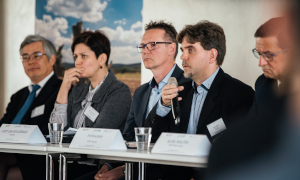Emphasizing the importance of a joint approach towards proactive and integrated drought management in the region, the event was organized in the frame of DriDanube projectin cooperation with the Drought Management Center for Southeastern Europe and the Integrated Drought Management Programme in Central and Eastern Europe, which is supporting the partners in the region in increasing their resilience towards drought since 2013.
It was attended by almost hundred participants from various sectors dealing with drought - national hydrometeorological services, ministries, universities, business sector, international organizations, non-governmental organizations etc. The conference brought a range of interesting speakers from Europe and overseas discussing topics from climate change challenges, through instruments for battling drought, drought risk and cross-sectoral impacts to strategic planning for drought.
One of the conclusions of the conference was, that knowledge on all aspects of drought (from monitoring to management) is available however to make use of it, better communication and more concrete actions are needed. Now that a momentum has been created, it is necessary to put all the efforts to sustain the DriDanube project results, especially Drought Watch and National Reporting Networks for which continued input from the countries is needed. Representatives of national institutions see the added value of this approach and they are willing to continue sharing their experiences gained during drought events and their national data. DriDanube tools are helping us to overcome national boundaries and see the broader perspective.
Since the improved drought monitoring, as well as drought impacts, are multi- dimensional, further improvement lies also in our understanding of multi-sectoral characterisation of drought itself. Panel on drought impacts in different sectors (hydropower, water-supply, agriculture, biodiversity, navigation) discussed that each sector gets affected by drought, which is causing different type of losses. It is important that each sector foresee its own specific gaps in overcoming drought losses. In order to manage drought in an integrated way, a better collaboration between different sectors is required.
dimensional, further improvement lies also in our understanding of multi-sectoral characterisation of drought itself. Panel on drought impacts in different sectors (hydropower, water-supply, agriculture, biodiversity, navigation) discussed that each sector gets affected by drought, which is causing different type of losses. It is important that each sector foresee its own specific gaps in overcoming drought losses. In order to manage drought in an integrated way, a better collaboration between different sectors is required.
Examples of good practices in drought management from Slovakia and Belgium were shared, where political will and occurrence of drought events triggered the change. For similar actions to take place and to manage drought in an integrated way in more countries of the Danube region, it requires collaboration within and between levels of government and private sector.

During the discussion on strategic positioning of drought on regional and national level it was clear that, in the last couple of years, a lot of efforts have been made to put “drought” on the political agenda and we are happy that some of those efforts is already reflecting in national and regional frameworks.
"Until now water scarcity and drought were not identified by the Danube countries as a significant water management issue on Danube basin wide level. DriDanube project is doing great job by influencing policy level feeding into a discussion whether drought should become a cross-cutting and inter-sectoral SWMI for the future.", Edith Hoedl, ICPDR.
significant water management issue on Danube basin wide level. DriDanube project is doing great job by influencing policy level feeding into a discussion whether drought should become a cross-cutting and inter-sectoral SWMI for the future.", Edith Hoedl, ICPDR.
